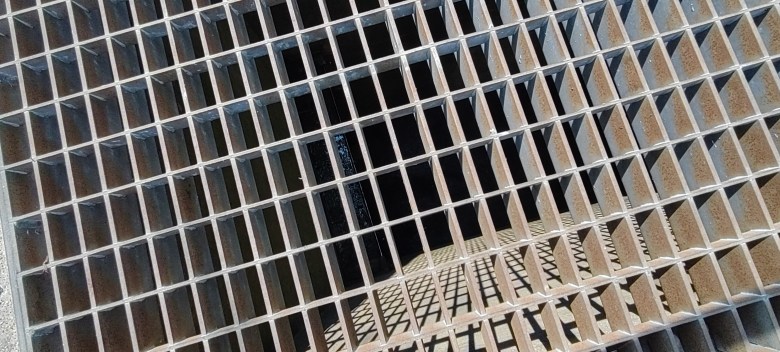Preliminary damage assessment teams began visiting homes on Chicago’s Southwest Side Wednesday, Aug. 13, and will be doing so through Sunday, Aug. 17, to gather and document information about flood damage from the July 25 to 28 flooding.
“The process consists of teams including personnel from the City of Chicago, the Illinois Emergency Management Agency, the U.S. Small Business Administration and Federal Emergency Management Agency are actually going door-to-door and having conversations with victims of the flood to assess what has taken place in order to work through and create this document to make a case for federal relief funding,” said Alderman Marty Quinn (13th).
Teams will begin knocking on doors at approximately 9:30 a.m.
 Close up of a flood grate reveals an approximately 300-foot deep shaft that connects to the Metropolitan Water District Reclamation system. Water could be heard but not seen flowing below. (Photo by Robin Sluzas)
Close up of a flood grate reveals an approximately 300-foot deep shaft that connects to the Metropolitan Water District Reclamation system. Water could be heard but not seen flowing below. (Photo by Robin Sluzas)
There are 3,200 homes in the area hard hit by the July storms.
Teams will not be speaking to persons in each residence but will gather information from a sample size and have conversations with impacted persons, Quinn said.
All investigators will have proper identification. Chicago’s OEMC issued a press release on Aug. 12 providing additional information about the visits.
Residents do not have to prepare for team visits.
“The visits will be done via conversation and looking at photos to further the case for needed federal money by developing the necessary data points,” Quinn said.
Physical assessments, meaning entering homes, will not take place, he added.
“After the preliminary assessment process ends on Sunday the 17th, they’ll compile all that data and turn it over to the federal government in the hope that relief opportunities will be there,” Quinn said.
There is more than one opportunity to get relief from the federal government, according to the alderman.
“One is through the federal government and the other is through direct check-to-homeowner,” he said. “We’ve seen that in the past. I think all of that remains to be seen based on the outcome of this joint preliminary damage assessment.”
Creation of the 311 emergency call record by the city and county, along with the State of Illinois and completed surveys got FEMA into the area, he added.
“The process is a very fluid process,” Quinn said. “This is the next big step in determining whether there will be relief from the federal government.”
Quinn will not accompany the assessment teams.
“I will not; I was not invited,” he said. “I did have a conversation with OEMC’s Acting Director Frank Velez, that he should consider my offices as his offices over the next couple of days so I anticipate us having a lot of interaction with the teams that are going to be out there. There will be six in the City of Chicago.”
Previously, 13th Ward residents asked Quinn questions about the July 25-28 flood who forwarded them to Chicago Water Commissioner Randy Connor who provided answers in an Aug. 4 letter.
Why do basements flood?
When the city’s combined sewer system floods during extreme rainstorms, the system may not be able to push water out as fast as it comes in causing flooding basement for three reasons: seepage (saturated ground water comes in through basement cracks), street sewer backups (water overwhelms sewer capacity) or house to street drain pipes clog (due to tree roots or pipe collapse), Connor said.
Homeowners may be eligible for assistance via the Private Drain Program provided by the Dept. of Water Management when collapsed pipes are under the public right-of-way, the letter indicated.
Floodgates/Locks?
The City of Chicago and Department of Water Management sewer system does not have locks or gates. The Chicago Area Water System navigation locks or controls are not part of the Metropolitan Water Reclamation District.
The CAWS system can help minimize flooding. Lake Michigan is higher than the Chicago River so a closed lock helps regulate river water levels preventing flooding during heavy rains. Opening the locks releases excess water into the lake only after river water level exceeds the level of Lake Michigan, Connor added.
“The lock’s operation is a consequence of the conditions that cause backups, not the cause of the backups themselves,” he said.
Geysers at 6200 and 5900 S. Nashville.
Sewer infrastructure at these locations experienced rapid stormwater filling, resulting in high pressure release or a geyser. As water rushes through trapped pockets of air, often at large tunnel junctions incoming water compresses trapped air, increasing pressure. “Think of it like a giant pressurized air bubble,” he said.
“When the pressure becomes too high, the air and water forcefully eject through the path of least resistance, typically a manhole or vertical shaft, creating a geyser effect,” according to the letter Connor sent.
State Senator Mike Porfirio (D-11th) has collaborated with IEMA on relief efforts and has stayed attentive to the evolving FEMA aid process.
Porfirio remains hopeful aid will be announced by FEMA soon, he said in an Aug. 11 email statement to the Southwest News-Herald.
Meanwhile, Quinn and staff continue the effort to continue representing constituents.
“This situation continues to remain fluid and I continue to push the envelope from questions being asked of me by my constituents so everyone has the same information I have,” Quinn said. “It’s in times like these, when folks really need government, we need to be there pushing out as much information as possible.”
Related
